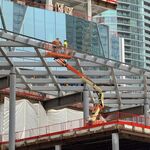Bordercollie
Senior Member
I would think that it's not as simple as reinforcing the plow, which was the case with the Hyundai cars. The concern is likely less with head on train collisions but more so with vehicles at level crossings. This is why in California they stopped using them as lead cars.But as for the 200-214, I heard they may get some structural changes done on the inside to atleast give them some level of protection in the event of an accident.
If they found a way to reinforce the front structure of the cab without changing the design too much that would be good to protect the operator.




